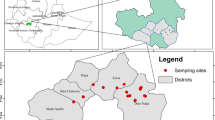Abstract
Taylor Slough, in Everglades National Park, has experienced an evolution of water management infrastructure since drainage activities arrived in South Florida. This has included the excavation of canals, installation of large capacity pump stations, and a variety of operational strategies focused on resolving the conflict between managing the water level for developed areas while providing water supply for Everglades National Park. This study provides a review of water management practices and the concurrent hydrologic conditions in the Taylor Slough basin and adjacent canal system from 1961 through 2010. Analyses of flow, water level and rainfall data were divided into time periods that correspond to significant changes in structural features and operational plans. In the early 1960s, Taylor Slough was disconnected from the greater Everglades system by the construction of levees upstream. As water supply for Taylor Slough became more urgent, the Slough was connected to the regional water supply system via a network of canals and pump stations to relieve over-drained conditions. The increased water supply and pump capacity succeeded in raising water level and increasing flow and hydroperiod in the marsh.








Similar content being viewed by others
References
Armentano TJ, Sah JP, Ross MS, Jones DT, Cooley HC, Smith CS (2006) Rapid responses of vegetation to hydrological changes in Taylor Slough Everglades National Park, vol. 569. Hydrobiologia, Florida, USA, pp 293–309
Causarus CR (1985) Geology of the surficial aquifer system, broward county, Florida. U.S. geological survey water resources investigations report 84–4068
Craighead SrFC (1971) The trees of South Florida, vol. 1. University of Miami Press, Coral Gables
Desmond G (2007) High accuracy elevation data collection project. US Geological Survey Fact Sheet FS-162-96
Fish JE, Stewart M (1990) Hydrology of the surficial aquifer system, Dade County, Florida. US Geological Survey Water Resources Investigations Report 90-4108
Godfrey MC, Catton T (2011) River of interests: water management in South Florida and the Everglades, 1948-2000. US Government Printing Office, Washington DC
Harvey JW, Jackson JM, Mooney RH, Choi J (2000) Interaction between ground water and surface water in Taylor Slough and vicinity, Everglades National Park. South Florida: Study methods and appendixes. US Geological Survey Water Open File Report 2000-483
Hofstetter RH, Sonenshein R (1990) Hydrologic effects of well-field operations in a wetland, Dade County, Florida. US Geological Survey Water Resources Investigations Report 90-413
Johnson R, Wagner J, Grigsby D, Stern V (1988) Hydrologic effects of the 1984 through 1986 L-31(W) canal drawdowns on the northern Taylor Slough basin of Everglades National Park. South Florida Research Center. Technical Report 88-01
Leach SD, Klein H, Hampton ER (1972) Hydrologic effects of water control and management of southeastern Florida. Florida Department of Natural Resources. Report of Investigations No. 60
McVoy CW, Said WP, Obeysekera J, VanArman JA, Dreschel TW (2011) Landscapes and hydrology of the predrainage Everglades University Press of Florida, Gainesville
Otero JM (1995) Computation of flow through water control structures. South Florida Water Managment District. Technical Publication 95-03
Rantz SE (1982) Measurement and computation of streamflow: Volume 2. In: Computation of discharge. US Geological Survey Water Supply Paper 2175
Rose PW, Flora MD, Rosendahl PC (1981) Hydrologic impacts of L-31(W) on Taylor Slough Everglades National Park. South Florida Research Center. Technical Report T-612
Searcy JK, Hardison CH (1960) Double-mass curves, manual of hydrology: part 1. general surface-water techniques U.S. Geological Survey Water Supply Paper 1541-B
U.S. Army Corps of Engineers (1961) Survey-review report on central and Southern Florida Project South Dade County. Central and Southern Florida Project Report
U.S. Army Corps of Engineers (1963) General design memorandum South Dade County.. Central and Southern Florida Project Report
U.S. Army Corps of Engineers (1967) Detail design memorandum, Levee 31(W); Canal 113, and Control Structures 174 and 175, Central and Southern Florida Project. Coastal Areas South of St. Lucie Canal. Central and Southern Florida Project, Part V
U.S. Army Corps of Engineers (1994) Central and Southern Florida Project Report, Florida Project for Flood Control and Other Purposes, Canal 111 (C-111) South Dade County. Draft Integrated General Reevaluation Report and Environmental Impact Statement. Central and Southern Florida Project Report, Florida
U.S. Congress (1968) Public law 90-483. River and Harbor Act of 1968 US Government Printing Office. Washington D.C.
U.S. Congress (1983) Public law 98-63 Supplemental Appropriations Act of 1983. US Government Printing Office, Washington D.C.
VanLent TJ, Johnson RA, Fennema R (1993) Water management in Taylor Slough and effects on Florida Bay South Florida Research Center. Technical Report 93-03
Acknowledgments
We would like to thank Jerry Lorenz and Pamela Sullivan who who provided helpful guidance and encouragement that was instrumental in finishing this manuscript. In addition, this analysis of observed data would not be possible without the forethought and dedication of state, local and federal agency staff who began collecting information related to the hydrology of South Florida so many years ago. We hereby sincerely acknowledge and thank them for their efforts. We also would like to particularly acknowledge the National Park Service for providing us the unique opportunity to study this fascinating ecosystem.
Author information
Authors and Affiliations
Corresponding author
Rights and permissions
About this article
Cite this article
Kotun, K., Renshaw, A. Taylor Slough Hydrology. Wetlands 34 (Suppl 1), 9–22 (2014). https://doi.org/10.1007/s13157-013-0441-x
Received:
Accepted:
Published:
Issue Date:
DOI: https://doi.org/10.1007/s13157-013-0441-x




